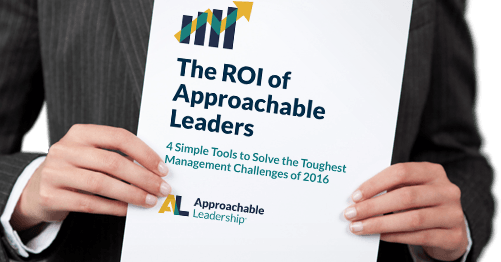
Retention Problems?
One leader behavior reduces turnover intention by
%
Want to know what it is?
Watch the video.
What People are Saying…
How Approachable Leadership Helps Reduce Turnover and Improve Retention…
Change Leadership: What You Need to Know From the Get-Go
Change Leadership is a hard job. And it’s never ending.
This is because change is a routine part of life – a blessing and a curse. American journalist, Sydney Harris put it this way:
“Our dilemma is that we hate change and love it at the same time; what we really want is for things to remain the same but get better.”
Humans are made for change, but we can also be overwhelmed by it. Especially the speed of change. It’s important that, as leaders and people, we understand the human nature of resistance to change. And how that resistance burns up both physical and emotional energy.
The Coaching Habit: Interview with Michael Bungay Stanier
If you haven’t stumbled across The Coaching Habit yet, now’s the time.
The Coaching Habit is sneaky-sophisticated. And better yet, easy to read. Being such a fan of the book, I was so grateful when the author, Michael Bungay Stanier, agreed to take a few minutes to give us some insight.
Here’s our conversation.
Phil: What inspired you to write The Coaching Habit?
Michael: My company earns its way by teaching busy managers how to coach in 10 minutes or less. The book grew out of lessons taught and lessons learned. And behind all of that was my desire to make coaching…or better said, being more coach-like…something that everyone feels they can do.
Phil: What do you think are the top 3 takeaways leaders will get from your book…
Staff Appreciation: The Hidden Key to Solve Resistance to Change
What does staff appreciation have to do with managing change?
Everything.
ATD’s Change Again? article gives some hard-to-ignore reasons for why you want to focus on staff appreciation when managing change.
“When staff feel appreciated, resistance diminishes.”
Remember the three reasons people resist change.
They don’t get it (an information gap);
They don’t like it (an emotional reaction); or
They don’t like you (a relational trust issue).
Think about how staff appreciation impacts each of these three areas.
When a person doesn’t feel appreciated, it’s safe to assume that there’s a lot of noise going on in his head. Most of the time he’s just talking to himself. Why does he stay? Is there some place else he could be? Somewhere he could get more recognition? Do something different? Maybe make more money? Meanwhile, he’s trying to find the headspace to actually get his work done. Then you throw a new change effort on top of that.
Managing Change: 3 Reasons People Resist Change
Managing change is difficult.
It’s one of the hardest things for leaders to get right. This is because effectively managing change requires leaders to put strategy aside and get real with their people.
Remember our article on Boston Consulting Group’s DICE model? This model is such a valuable resource for those looking to assess the hard factors behind managing change. Have you set a clear and attainable timeline? Did you thoughtfully configure the team? Did you designate the appropriate kind of leader? (The people person rather than the over-achiever.) Have you considered how this change project affects the other duties of your team? Does some work need redistributed?
How to Be a Good Manager: Create the Right Space
Wondering how to be a good manager? Great question.
Do you want to know how to be a good manager? For us, it’s simple. You must be less invading and more inviting. When things get stressful (and let’s face it, these days when aren’t they stressful) it is easy for you to become an additional burden to your team. But that’s when leaders get headed down the wrong path. People don’t grow, excel, or shine when they have no room to breathe.
When we teach leaders how to be a good manager we explain the key to keeping morale high without suffocating your team through micro-management is to create a comfortable space where they come to you when things are off track. Think about the space around you. The energy you put off. The ease with which someone feels they can approach you. When they do approach you, do you invite the interruption or are you put off by it?
Change Your Perspective and Change Everything: Fall in Love with Your Job Part 3 of 3
Can you really change everything if you change your perspective?
Why not? There is one thing we know for sure. The way you see your self, your work, your friends, your world, has a direct connection to the way you feel about your self. Your work. Your friends. Your world. There are many things in life that are outside our control. But our perspective is not one of them. Change your perspective and you just might change everything.
This is the last bit of advice David Allan gives us on how to fall in love with your job. We wrote about the first two steps – hacking your job and improving relationships with coworkers – here and here.
People want to feel like their work is meaningful. We say that a lot these days. Do you believe it yet? Maybe you’re one of the people still trying to come around to that perspective. (Ah, perspective). We understand. Twenty years ago, few people required meaning to stay at a job. That doesn’t mean they didn’t crave it. Or didn’t feel the effects of the lack there of. It just means they wouldn’t quit their job over it. That’s not true anymore.
How to Get Along with Coworkers: Fall in Love with Your Job Part 2 of 3
If you can’t get along with coworkers you won’t love your job.
Recently we discussed David Allan’s first tip for falling in love with your job—hack it. This is part 2 of 3 in the How to Fall in Love with Your Job series.
Allan’s second tip has to do with how to get along with coworkers.
We all know that coworkers mostly fall into the “things about my job that I don’t have control over” category. We don’t get to pick who we work with. But the fact is, how we get along with coworkers (our relationships with them) has a direct impact on our daily lives. It can impact how we feel about ourselves and our work. And we do have control over how we choose to interact with people placed into our lives.
Here are three tips for how to get along with coworkers.
How to Fall In Love with Your Job: Part 1 of 3
You have the power to take control of your job.
More than half the people in the U.S. don’t like their jobs. This, according to the Conference Board Research Group in their most recent annual survey. What’s more, our nation has been hovering at this spot for at least the last 16 years.
It’s not that surprising though is it? Most people’s day jobs have very little to do with their passions. Sure, on occasion, we get a spark of accomplishment from our jobs. We enjoy a good challenge or creative brainstorming session. But for the most part, we work because we must work. And most days we’d prefer to be somewhere else. But we show up. We’re always going to show up. And if we’re going to show up, why not make the most of it?
Phil Featured in Fast Company Piece on Approachability
Earlier this week, Fast Company released an article all about learning how to put your team at ease. Gwen Moran, author of the piece, provides 8 simple ways to be more approachable and "fine-tune" your communication skills. Guess who kicked off the discussion? That's...
Approachability Window Tool | Approachability Minute
Relationships are a two way street.
This is what makes them so challenging. As a leader who wants to have great relationships with your team, it’s easy to think that knowing that about yourself is enough. But what about all the things you don’t know about yourself. The things people see in you that you don’t see in yourself.
Do us a quick favor? Get something in return.
We could really use your help. We want to make our content as relevant to our readers as possible. In order to do this, we need to know what's working for you and what's not. If you can spare a minute (it will literally take less than 60 seconds) please click here to...
Recognizing Gaps Tool | Approachability Minute
People are not just going to come up to you and say “Hey, I’m uncomfortable approaching you.”
That’s why it’s so important that we as leaders learn to recognize the signs associated with approachability. This is what our tool, the Recognizing Gaps Tool, is all about. It teaches you the three main areas to look at in order to discover just how comfortable your team members are with you. This is extremely important information to know as your level of approachability directly effects your knowledge of what is actually going on in your organization and amongst your team.
Stop the Turnover Madness: How to Make Your Employees Want to Stay
Turnover is expensive.
Turnover costs companies anywhere from 16% to over 300% of annual salary (for the highly skilled—the ones most likely to leave). Companies lose productivity, valuable organizational memory, relationships, and often intellectual property. Critical activities stall and die while searching for new talent.
What’s more, nearly 20% of employees will voluntarily quit their job this year. You read that right: 20%. Why? With mortgages to pay, kids to clothe and put through college, and stuff to buy, what makes a person so fed up that they quit?
Their leaders.
The fact is that to a very large degree your relationship with your people is the difference between whether people stay or go. That’s what makes leadership such a tough gig. You are the glue.
What can we do to stop the turnover madness?
Active Disengagement: 3 Ways Leaders Can Turn It Around
Active disengagement costs US companies between $450 and $550 billion annually. Does active disengagement at your company contribute to that shockingly high number? I've got bad news - it does. Every company does its share. Because we all have actively disengaged...

























